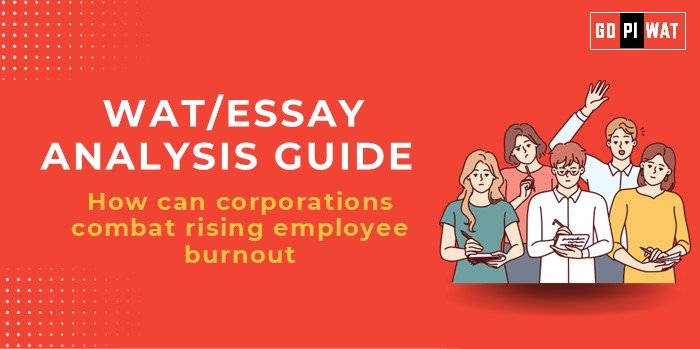📋 WRITTEN ABILITY TEST (WAT)/ESSAY ANALYSIS GUIDE
🌟 Understanding the Topic’s Importance
Combating employee burnout is a critical theme in management studies, linking organizational performance with human resource management and mental health policies.
📝 Effective Planning and Writing
- Time Allocation:
- Planning: 5 minutes
- Writing: 20 minutes
- Review: 5 minutes
- Preparation Tips:
- Gather statistics and examples like Salesforce or Deloitte.
- Structure arguments with evidence and global comparisons.
✨ Introduction Techniques for Essays
- Contrast Approach:
“While corporations aim for productivity, rising employee burnout due to excessive workloads remains an alarming contradiction in today’s work culture.” - Solution-Based Approach:
“Employee burnout can be mitigated with strategic policies focusing on flexible hours, mental health support, and managerial training.” - Statistical Introduction:
“59% of global employees face burnout, costing businesses billions annually—highlighting the urgent need for corporate interventions.”
📖 Structuring the Essay Body
- Achievements: Flexible work hours, EAPs, and wellness platforms have shown success in reducing stress and improving retention.
- Challenges with Comparative Analysis:
- Persistent overwork culture in countries like Japan.
- Lack of mental health programs in smaller corporations.
- Future Outlook:
- Greater investment in leadership training.
- Leveraging AI tools for monitoring employee well-being.
🏁 Concluding Effectively
- Balanced Perspective:
“While progress has been made in addressing burnout, corporations must adopt systemic changes alongside wellness initiatives to create sustainable solutions.” - Global Comparison Conclusion:
“By adopting models from Denmark or Japan, businesses can strike a balance between productivity and employee well-being.”
📊 Analyzing Successes and Shortcomings
- Key Achievements: Increased awareness, EAP growth, flexible work models.
- Ongoing Challenges: Overwork culture, stigma, and leadership gaps.
- Global Context: Denmark’s shorter workweek and Japan’s reforms provide actionable insights.
💡 Recommendations for Sustainable Progress
- Implement leadership training programs emphasizing empathy and emotional intelligence.
- Offer mandatory mental health leaves and flexible work arrangements.
- Utilize AI and digital tools to monitor workload patterns and employee well-being.
📝 Sample Short Essays
Balanced Perspective:
“Combating employee burnout requires a blend of flexible policies and organizational restructuring. Companies like Salesforce demonstrate how prioritizing mental health leads to higher productivity and satisfaction.”
Solution-Oriented:
“To tackle burnout, corporations must prioritize flexible hours, mental health resources, and leadership reforms, ensuring systemic changes that prioritize employee well-being.”
Global Comparison:
“Adopting Denmark’s shorter workweek model and Japan’s work-life balance reforms can guide corporations to create a healthier, more sustainable work environment.”


